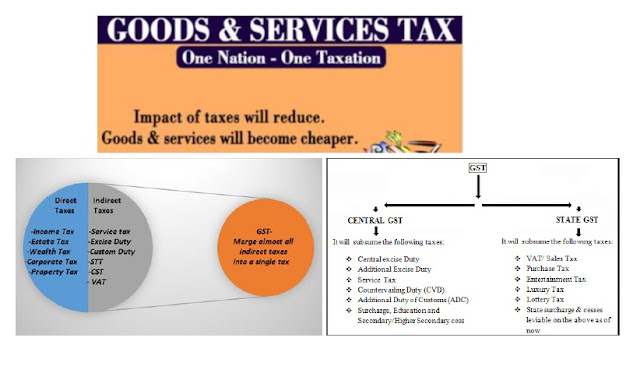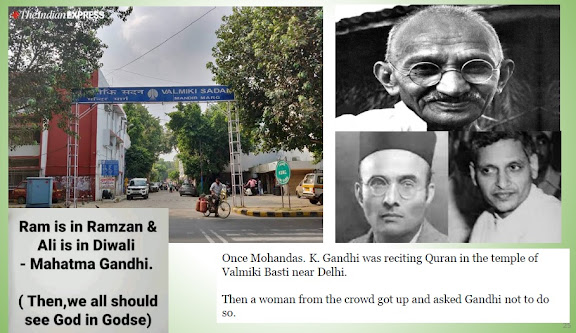GOOD AND SERVICES TAX (GST)
Goods and Services Tax Bill or GST Bill
which is officially known as The Constitution (122 Amendment) Bill, 2014 is set
to become operational from the 1st April 2017.
This bill is widely hailed as a historical tax reform , as it
is expected to transform India into a unitary market, lower transaction and
logistics costs, spread the tax net wider and propel investments and
growth.
As of now, Indirect Taxes suffer from
multiple taxations on different rates by different States with increased
cascading effect of tax on the cost of goods and services due to ‘Tax on Tax’
and worst the ‘Tax Terrorisms’ on the economy - manufacturers, traders and even
consumers. GST is addressing these problems by
amalgamating several Central and State taxes into a single tax thereby
mitigating cascading or double taxation. And this will aim at ‘One Nation – One
Taxation’ which will go a long way in making India a most favoured nation for
investments thereby India becoming a Developed Nation sooner than expected.
From the consumer point of view, the biggest
advantage would be in terms of a reduction in the overall tax burden on goods,
which is currently estimated at 25% - 30%, free movement of goods from one
state to another without stopping at state borders for hours for payment of
state tax or entry and reduction in paperwork to a large extent.
There will be revenue losses to some
states with the introduction of GST, but, the Central Government has proposed
to insulate the revenue losses incurred by them from the date of introduction
of GST for a period of five years. Another major problem for the new GST
Council proposed to be set up under the Bill would be to decide on the
applicable tax rate. In order to protect the revenues of both the Centre and
the States, applicable tax rate should be fixed on the basis of revenue neutral
rate (RNR). But, it is felt that fixing a ceiling on revenue-neutral rate - at
18% as recommended by the Congress is self-defeating, if the same is included
in the Constituent Amendment Bill. If
that is done, in the event that the rate needs to be changed, the Central
Government has to adopt the whole constitutional amendment procedure and the
RNR will be got into this rigid procedure for something as simple as the rate,
which should be easier to change. Jaitley
rightly ruled out including GST rate in constitution bill saying that tariffs
cannot be cast in stone.
Why do we need GST? - can be briefly
explained.
Here A sells goods to B who in turn sells
to C and C is loading all sales taxes of A and B apart from his own sales tax
on the head of the ultimate consumer and this cascading effect becomes a tax on
tax. But GST with its Dual GST Model, this tax on tax is removed. Under Dual
GST Model, there are only three types of taxes to be levied on each kind of
transaction.
1.SGST – State GST, collected by the
State Govt.
2.CGST – Central GST, collected by the
Central Govt.
3.IGST – Integrated GST, collected by the
Central Govt.
Now let us see how GST operates
and how these State and Central taxes are applied?
Case 1: Sale in one state, resale in the same
state:
It is a sale within a State - from Mumbai
to Pune, CGST and SGST will be levied and the collection goes to the Central
Government and the State Government as indicated below. Then the goods are
resold from Pune to Nagpur, this again a sale within a state, so CGST and SGST
levied.
Case 2: Sale in one state, resale in
another state:
Goods are moving from Indore to Bhopal -
it is a sale within a state - CGST & SGST levied. Collected taxes go to
State and Central Governments.
Goods are resold from Bhopal to Lucknow -
it is outside state - IGST levied. Collected tax goes to Central
Government. Note that both the input
taxes are taken as credit. Note that SGST never went to the Central Government,
still the credit is claimed. This is the crux of GST. Since this amounts to a
loss to the Central Government, the state government compensates the central
government by transferring the credit to the central government.
Case 3: Sale outside the state, resale in
that state:
Goods moving from Delhi to Jaipur
(outside the state) and then goods are resold from Jaipur to Jodhpur (within
the state).
Outside the state: Being interstate sale,
IGST alone levied. Collection goes to Central Government.
Within state sale: CGST and SGST levied.
Note: Against CGST and SGST, 50% of the
IGST, that is Rs.8 is taken as a credit. But wee that IGST never went to the
state Government, still the credit is claimed against SGST. Since this amounts
to a loss to the State Government, the Central Government compensates the state
government by transferring the credit to the State Government.
Some More ADVANTAGES OF GST
Apart from full allowance of credit,
there are several other advantages of introducing a GST in India:
•Possible reduction in prices
•Increase in Government Revenues
•Less compliance and procedural cost
One Major advantage of GST is that it
will reduce tax evasion. All traders will insist on taking bills for all their
purchases, as it gives them a better profit margin. This is explained here with
an example. See
the display on the left.
Suppose you are a mobile phone
distributor. You are buying mobile phones from the manufacturer and selling to
wholesaler.
The net position after introduction of GST is
detailed in the display in the chart below:
As we can see, in GST scenario, net
profit for the distributor with invoice is Rs.5000/- whereas without invoice
his net profit is only Rs.4000/-. Now, if the customer himself insists on
taking the bill, we can assume that tax evasion will fall. This is the biggest
advantage of GST.
Even after the introduction of GST,
petroleum shall continue as it is, because GST on petroleum products has been
deferred as per the latest bill. Even Import Customs Duty is exempt from
GST.
In short, the introduction of goods and
services tax will lead to the abolition of taxes such as octroi,
Central sales tax, State level sales tax, entry tax, stamp duty, telecom
licence fees, turnover tax, tax on consumption or sale of electricity, taxes on
transportation of goods and services, and eliminate the cascading effects of
multiple layers of taxation. It will boost up economic unification of India; it
will assist in better conformity and revenue resilience; it will evade the
cascading effect in Indirect tax regime.
Conclusion
A Well designed GST will lower the tax
rate by broadening the tax base and minimizing exemptions. It will foster a
common market across the country and reduce compliance costs. It will
facilitate investment decisions being made on purely economic concerns,
independent of tax considerations. It will promote exports. GST will also
promote employment. Most importantly, This results in better administration of
tax.









Comments